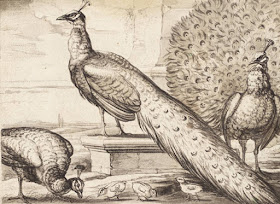Peacock chintz
Stuffed quilt attributed to Amelia Heiskell Lauck, Collection of
Colonial Williamsburg # 2008.609.6.
Circa 1825
http://emuseum.history.org/view/objects/asitem/Objects@81279/1?showSite=mobileThe second of Amelia's Aviary is this peacock quilt. The catalog reads:
"Although not signed by Amelia Lauck, the quilt can be attributed to her. Like a signed quilt by Amelia Lauck in the collection, this one is configured in a framed center-medallion format with concentric borders of alternating stuffed-work quilting and pieced sawtooth and zigzag patterns with eight-pointed stars in the corners. It uses many of the same printed cottons. A trademark of Amelia’s quilts is the intricate quilting patterns that were given added dimension with cotton stuffing."
See a recent post on a partridge print in Amelia's quilt here:
The source for Amelia's birds in this quilt were easier for me to
find than her partridges. In the corners of the central wreath are
a peacock and a pea hen.
The peacock with his impressive tail is looking to the left.
Most of the yardage I've seen features the same bird looking
to the right. His body faces left but his head turns to the right.
Mrs Peacock, the peahen, also faces the right.
the opposite of the pen hen in the Lauck quilt.
Winterthur Museum collection #1969-3805-004
In this piece with a blue blotch ground you can see the pea family in yellow.
The peahen seems to be smiling at her three chicks.
Amelia didn't include the chicks in her applique.
Although the maker of this quilt found in the Connecticut project found a way to use
them in her border.
IQSCM # 2006-0005-0001
The peacock & peahen fabric was another popular print in the
U.S. in the 1825-1850 era.
"Printed in Britain: 1820s.
This high-quality block-printed design features peacocks on a tea ground and is reminiscent of the work of Francis Barlow. His designs, originally published in the late seventeenth century were copied and revived for centuries."
Watercolor by Francis Barlow (?1626–1704)
Collection of the Tate Britain.
The source for the chicks and the female.
Amelia's quilt has a rather bird-like shape in the center. It doesn't look
like a peacock and I was discouraged about looking for such a vague image
until I noticed a similar bird lurking in the rose bushes around the peacock family above
the peacock's tail.
He has that awkward look that Audubon's birds often do---
As if he was drawn from a dead bird (he probably was).
Amelia liked him well enough to put him and the roses in the center of her medallion.
As I noted Amelia's yardage seems to have a flipped design. I found another quilt
with the peacock and pea hen images also flipped to face the other way.
Now, it could be that the photos are flipped---a mistake easily made in the old
days of transparencies.
Cut-out-chintz quilt attributed to Arianna Sollers Bouldin (1816-1870),
Baltimore in the collection of the DAR Museum.
Arianna used more chintzes than Amelia in her masterpiece here,
but they have a lot in common, particularly gorgeous stuffed-work quilting.
Amelia's peacock
Arianna's peacock
Do also note the similar stuffed flower of 7 dots above both birds' backs.
Another left-facing peacock in a quilt shown at the Folsom History Museum's annual show
about 5 or 6 years ago.
Old Sturbridge Village collection from Mass Quilts & the Quilt Index.
Although it's hard to see in the small photo, the peacock facing left and pea hen are
at the base of this tree.
Cooper Hewitt collection
This is the only yardage I've found with the bird
facing that direction---again, could be a flipped photo.
I solved the mystery of where Amelia Lauck found her peacock and pea hen but the most interesting question remains:
What did Ariana Sollers Bouldin and Amelia Heiskell Lauck have in common besides some peacock fabric and a quilting pattern?
























Many parents name twins with similar names... perhaps they are twins? What does their family background look like, were they from the same area, cousins?
ReplyDelete